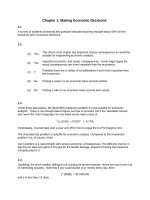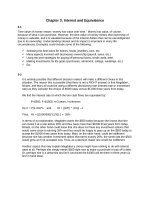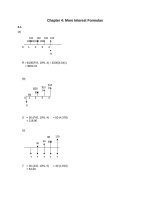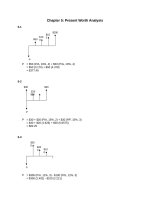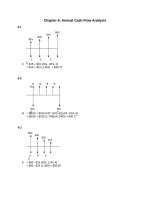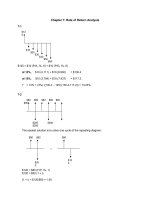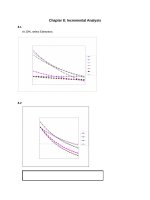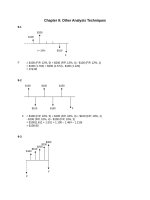Solution manual engineering mechanics dynamics 12th edition chapter 19
Bạn đang xem bản rút gọn của tài liệu. Xem và tải ngay bản đầy đủ của tài liệu tại đây (10.81 MB, 48 trang )
91962_09_s19_p0779-0826
6/8/09
4:38 PM
Page 779
© 2010 Pearson Education, Inc., Upper Saddle River, NJ. All rights reserved. This material is protected under all copyright laws as they currently
exist. No portion of this material may be reproduced, in any form or by any means, without permission in writing from the publisher.
•19–1. The rigid body (slab) has a mass m and rotates with
an angular velocity V about an axis passing through the
fixed point O. Show that the momenta of all the particles
composing the body can be represented by a single vector
having a magnitude mvG and acting through point P, called
the center of percussion, which lies at a distance
rP>G = k2G>rG>O from the mass center G. Here kG is the
radius of gyration of the body, computed about an axis
perpendicular to the plane of motion and passing through G.
HO = (rG>O + rP>G) myG = rG>O (myG) + IG v,
where
mvG
V
vG
rG/O
P
rP/G
G
O
IG = mk2G
rG>O (myG) + rP>G (myG) = rG>O (myG) + (mk2G) v
rP>G =
However,
k2G
yG>v
yG = vrG>O or rG>O =
rP>G =
yG
v
k2G
rG>O
Q.E.D.
19–2. At a given instant, the body has a linear momentum
L = mvG and an angular momentum H G = IG V computed
about its mass center. Show that the angular momentum of
the body computed about the instantaneous center of zero
velocity IC can be expressed as H IC = IIC V , where IIC
represents the body’s moment of inertia computed about
the instantaneous axis of zero velocity. As shown, the IC is
located at a distance rG>IC away from the mass center G.
HIC = rG>IC (myG) + IG v,
where
mvG
G
IGV
rG/IC
yG = vrG>IC
IC
= rG>IC (mvrG>IC) + IG v
= (IG + mr2G>IC) v
= IIC v
Q.E.D.
19–3. Show that if a slab is rotating about a fixed axis
perpendicular to the slab and passing through its mass center
G, the angular momentum is the same when computed about
any other point P.
V
P
G
Since yG = 0, the linear momentum L = myG = 0. Hence the angular momentum
about any point P is
HP = IG v
Since v is a free vector, so is H P .
Q.E.D.
779
91962_09_s19_p0779-0826
6/8/09
4:39 PM
Page 780
© 2010 Pearson Education, Inc., Upper Saddle River, NJ. All rights reserved. This material is protected under all copyright laws as they currently
exist. No portion of this material may be reproduced, in any form or by any means, without permission in writing from the publisher.
*19–4. The pilot of a crippled jet was able to control his
plane by throttling the two engines. If the plane has a weight
of 17 000 lb and a radius of gyration of kG = 4.7 ft about the
mass center G, determine the angular velocity of the plane
and the velocity of its mass center G in t = 5 s if the thrust in
each engine is altered to T1 = 5000 lb and T2 = 800 lb as
shown. Originally the plane is flying straight at 1200 ft>s.
Neglect the effects of drag and the loss of fuel.
G
T2
1.25 ft
T1
1.25 ft
(a +)
(HG)1 + ©
L
MG dt = (HG)2
0 + 5000(5)(1.25) - 800(5)(1.25) = c a
17 000
b(4.7)2 dv
32.2
Ans.
v = 2.25 rad>s
+ b
a:
m(vGx)1 + ©
a
L
Fx dt = m(vGx)2
17 000
17 000
b (1200) + 5800(5) = a
b(vG)2
32.2
32.2
(vG)2 = 1.25 A 103 B ft>s
Ans.
•19–5. The assembly weighs 10 lb and has a radius of
gyration kG = 0.6 ft about its center of mass G. The kinetic
energy of the assembly is 31 ft # lb when it is in the position
shown. If it rolls counterclockwise on the surface without
slipping, determine its linear momentum at this instant.
0.8 ft
yG
yG
=
Kinetic Energy: Since the assembly rolls without slipping, then v =
rG>IC
1.2
= 0.8333yG.
T =
31 =
1 ft
G
1 ft
1
1
my2G + IG v2
2
2
1 10
1 10
a
b y2G + c
A 0.62 B d(0.8333yG)2
2 32.2
2 32.2
yG = 12.64 ft>s
Linear Momentum: Applying Eq. 19–7, we have
L = myG =
10
(12.64) = 3.92 slug # ft>s
32.2
Ans.
19–6. The impact wrench consists of a slender 1-kg rod AB
which is 580 mm long, and cylindrical end weights at A and B
that each have a diameter of 20 mm and a mass of 1 kg. This
assembly is free to rotate about the handle and socket, which
are attached to the lug nut on the wheel of a car. If the rod AB
is given an angular velocity of 4 rad>s and it strikes the bracket
C on the handle without rebounding, determine the angular
impulse imparted to the lug nut.
Iaxle =
L
C
B
1
1
(1)(0.6 - 0.02)2 + 2 c (1)(0.01)2 + 1(0.3)2 d = 0.2081 kg # m2
12
2
Mdt = Iaxle v = 0.2081(4) = 0.833 kg # m2>s
300 mm
Ans.
780
300 mm
A
91962_09_s19_p0779-0826
6/8/09
4:39 PM
Page 781
© 2010 Pearson Education, Inc., Upper Saddle River, NJ. All rights reserved. This material is protected under all copyright laws as they currently
exist. No portion of this material may be reproduced, in any form or by any means, without permission in writing from the publisher.
z
19–7. The space shuttle is located in “deep space,” where the
effects of gravity can be neglected. It has a mass of 120 Mg, a
center of mass at G, and a radius of gyration (kG)x = 14 m
about the x axis. It is originally traveling forward at
v = 3 km>s when the pilot turns on the engine at A, creating
a thrust T = 600(1 - e -0.3t) kN, where t is in seconds.
Determine the shuttle’s angular velocity 2 s later.
v = 3 km/s
G
A
T
2m
x
(HG)1 + ©
(a +)
L
y
MG dt = (HG)2
600 A 103 B A 1 - e -0.3 t B (2) dt = C 120 A 103 B (14)2 D v
2
0 +
L0
1200 A 103 B ct +
1 -0.3 t 2
d = 120 A 103 B (14)2 v
e
0.3
0
v = 0.0253 rad>s
Ans.
*19–8. The 50-kg cylinder has an angular velocity of
30 rad>s when it is brought into contact with the horizontal
surface at C. If the coefficient of kinetic friction is mC = 0.2,
determine how long it will take for the cylinder to stop
spinning. What force is developed in link AB during this
time? The axle through the cylinder is connected to two
symmetrical links. (Only AB is shown.) For the computation,
neglect the weight of the links.
20Њ
500 mm
Principle of Impulse and Momentum: The mass moment inertia of the cylinder about
1
its mass center is IG = (50) A 0.22 B = 1.00 kg # m2. Applying Eq. 19–14, we have
2
m A yGy B 1 + ©
(+ c )
0 + N(t) + 2FAB sin 20° (t) - 50(9.81)(t) = 0
m A yGx B 1 + ©
+ B
A:
Fy dt = m A yGy B 2
t2
Lt1
(1)
Fx dt = m A yGx B 2
t2
Lt1
(2)
0 + 0.2N(t) - 2FAB cos 20°(t) = 0
t2
IG v1 + ©
(a +)
Lt1
MG dt = IG v2
(3)
-1.00(30) + [0.2N(t)](0.2) = 0
Solving Eqs. (1), (2), and (3) yields
FAB = 48.7 N
V ϭ 30 rad/s
A
t = 1.64 s
Ans.
N = 457.22 N
781
200 mm
B
C
91962_09_s19_p0779-0826
6/8/09
4:40 PM
Page 782
© 2010 Pearson Education, Inc., Upper Saddle River, NJ. All rights reserved. This material is protected under all copyright laws as they currently
exist. No portion of this material may be reproduced, in any form or by any means, without permission in writing from the publisher.
•19–9. If the cord is subjected to a horizontal force of
P = 150 N, and the gear rack is fixed to the horizontal plane,
determine the angular velocity of the gear in 4 s, starting from
rest. The mass of the gear is 50 kg, and it has a radius of
gyration about its center of mass O of kO = 125 mm.
75 mm
P ϭ 150 N
150 mm
O
Kinematics: Referring to Fig. a,
vO = vrO>IC = v(0.15)
Principle of Angular Impulse and Momentum: The mass moment of inertia of the gear
about its mass center is IO = mkO 2 = 50 A 0.1252 B = 0.78125 kg # m2. From Fig. b,
t2
c + IP v1 + ©
Lt1
MP dt = IP v2
0 + 150(4)(0.225) = 0.78125v + 50[v(0.15)](0.15)
v = 70.8 rad>s
Ans.
782
91962_09_s19_p0779-0826
6/8/09
4:40 PM
Page 783
© 2010 Pearson Education, Inc., Upper Saddle River, NJ. All rights reserved. This material is protected under all copyright laws as they currently
exist. No portion of this material may be reproduced, in any form or by any means, without permission in writing from the publisher.
19–10. If the cord is subjected to a horizontal force of
P = 150 N, and gear is supported by a fixed pin at O,
determine the angular velocity of the gear and the velocity
of the 20-kg gear rack in 4 s, starting from rest. The mass of
the gear is 50 kg and it has a radius of gyration of
kO = 125 mm. Assume that the contact surface between
the gear rack and the horizontal plane is smooth.
75 mm
P ϭ 150 N
150 mm
O
Principle of Impulse and Momentum: The mass moment of inertia of the gear about
its mass center is IO = mkO 2 = 50 A 0.1252 B = 0.78125 kg # m2. Referring to the
free-body diagram of the gear shown in Fig. a,
t2
a + IO v1 + ©
Lt1
MO dt = IO v2
0 + F(4)(0.15) - 150(4)(0.075) = -0.78125vA
F = 75 - 1.302vA
(1)
Since the gear rotates about the fixed axis, vP = vA rP = vA(0.15). Referring to the
free-body diagram of the gear rack shown in Fig. b,
+ B
A;
t2
mv1 + ©
Lt1
Fxdt = mv2
0 + F(4) = 20[vA (0.15)]
F = 0.75vA
(2)
Equating Eqs. (1) and (2),
0.75vA = 75 - 1.302vA
vA = 36.548 rad>s = 36.5 rad>s
Ans.
v = 36.548(0.15) = 5.48 m>s
Ans.
Then,
783
91962_09_s19_p0779-0826
6/8/09
4:40 PM
Page 784
© 2010 Pearson Education, Inc., Upper Saddle River, NJ. All rights reserved. This material is protected under all copyright laws as they currently
exist. No portion of this material may be reproduced, in any form or by any means, without permission in writing from the publisher.
19–11. A motor transmits a torque of M = 0.05 N # m to
the center of gear A. Determine the angular velocity of each
of the three (equal) smaller gears in 2 s starting from rest.
The smaller gears (B) are pinned at their centers, and the
masses and centroidal radii of gyration of the gears are
given in the figure.
mA ϭ 0.8 kg
M ϭ 0.05 N и m
40 mm
Gear A:
A
(c +)
(HA)1 + ©
L
MA dt = (HA)2
B
mB ϭ 0.3 kg
0 - 3(F)(2)(0.04) + 0.05(2) = [0.8(0.031)2] vA
20 mm
Gear B:
(a +)
(HB)1 + ©
L
MB dt = (HB)2
0 + (F)(2)(0.02) = [0.3(0.015)2] vB
Since 0.04vA = 0.02 vB, or vB = 2 vA, then solving,
F = 0.214 N
vA = 63.3 rad>s
Ans.
vB = 127 rad>s
784
kB ϭ 15 mm
kA ϭ 31 mm
91962_09_s19_p0779-0826
6/8/09
4:41 PM
Page 785
© 2010 Pearson Education, Inc., Upper Saddle River, NJ. All rights reserved. This material is protected under all copyright laws as they currently
exist. No portion of this material may be reproduced, in any form or by any means, without permission in writing from the publisher.
*19–12. The 200-lb flywheel has a radius of gyration about
its center of gravity O of kO = 0.75 ft. If it rotates
counterclockwise with an angular velocity of 1200 rev>min
before the brake is applied, determine the time required for
the wheel to come to rest when a force of P = 200 lb is
applied to the handle. The coefficient of kinetic friction
between the belt and the wheel rim is mk = 0.3. (Hint:
Recall from the statics text that the relation of the tension
in the belt is given by TB = TC emb, where b is the angle of
contact in radians.)
1 ft
O
P
A
TB(1.25) - 200(3.75) = 0
1.25 ft
TB = 600 lb
Using the belt friction formula,
TB = TC emb
600 = TC e0.3(p)
TC = 233.80 lb
Principle of Angular Impulse and Momentum: The mass moment of inertia of the
200
wheel about its mass center is IO = mkO 2 = a
b A 0.752 B = 3.494 slug # ft2, and
32.2
rev
2p rad 1 min
ba
ba
b
the initial angular velocity of the wheel is v1 = a1200
min
1 rev
60 s
= 40p rad>s. Applying the angular impulse and momentum equation about point O
using the free-body diagram of the wheel shown in Fig. b,
t2
a+
IO v1 + ©
Lt1
B
C
Equilibrium: Writing the moment equation of equilibrium about point A and
referring to the free-body diagram of the arm brake shown in Fig. a,
a + ©MA = 0;
v
MO dt = IO v2
3.494(40p) + 233.80(t)(1) - 600(t)(1) = 0
t = 1.20 s
Ans.
785
2.5 ft
91962_09_s19_p0779-0826
6/8/09
4:41 PM
Page 786
© 2010 Pearson Education, Inc., Upper Saddle River, NJ. All rights reserved. This material is protected under all copyright laws as they currently
exist. No portion of this material may be reproduced, in any form or by any means, without permission in writing from the publisher.
•19–13. The 200-lb flywheel has a radius of gyration about
its center of gravity O of kO = 0.75 ft. If it rotates
counterclockwise with a constant angular velocity of
1200 rev>min before the brake is applied, determine the
required force P that must be applied to the handle to stop
the wheel in 2 s. The coefficient of kinetic friction between
the belt and the wheel rim is mk = 0.3. (Hint: Recall from the
statics text that the relation of the tension in the belt is given
by TB = TC emb, where b is the angle of contact in radians.)
1 ft
O
v
P
A
B
C
1.25 ft
Principle of Angular Impulse and Momentum: The mass moment of inertia of the
200
wheel about its mass center is IO = mkO 2 = a
b A 0.752 B = 3.494 slug # ft2, and
32.2
2p rad 1 min
rev
ba
ba
b
the initial angular velocity of the wheel is v1 = a1200
min
1 rev
60 s
= 40p rad>s. Applying the angular impulse and momentum equation about point O
using the free-body diagram shown in Fig. a,
t2
a+
IO v1 + ©
Lt1
MO dt = IO v2
3.494(40p) + TC (2)(1) - TB (2)(1) = 0
TB - TC = 219.52
(1)
Using the belt friction formula,
TB = TC emb
TB = TC e0.3(p)
(2)
Solving Eqs. (1) and (2),
TC = 140.15 lb
TB = 359.67 lb
Equilibrium: Using this result and writing the moment equation of equilibrium
about point A using the free-body diagram of the brake arm shown in Fig. b,
a + ©MA = 0;
359.67(1.25) - P(3.75) = 0
P = 120 lb
Ans.
786
2.5 ft
91962_09_s19_p0779-0826
6/8/09
4:42 PM
Page 787
© 2010 Pearson Education, Inc., Upper Saddle River, NJ. All rights reserved. This material is protected under all copyright laws as they currently
exist. No portion of this material may be reproduced, in any form or by any means, without permission in writing from the publisher.
19–14. The 12-kg disk has an angular velocity of
v = 20 rad>s. If the brake ABC is applied such that the
magnitude of force P varies with time as shown, determine
the time needed to stop the disk. The coefficient of kinetic
friction at B is mk = 0.4. Neglect the thickness of the brake.
P
500 mm
B
500 mm
C
200 mm
P (N)
400 mm
5
A
2
Equation of Equilibrium: Since slipping occurs at B, the friction Ff = mk NB = 0.4NB.
From FBD(a), the normal reaction NB can be obtained directed by summing
moments about point A.
a + ©MA = 0;
NB (0.5) - 0.4NB (0.4) - P(1) = 0
NB = 2.941P
Thus, the friction Ff = 0.4NB = 0.4(2.941P) = 1.176P.
Principle of Impulse and Momentum: The mass moment inertia of the cylinder
1
about its mass center is IO = (12) A 0.22 B = 0.240 kg # m2. Applying Eq. 19–14,
2
we have
t2
IO v1 + ©
(a +)
Lt1
MO dt = IO v2
-0.240(20) + c - a1.176
t
L0
Pdt b(0.2) d = 0
(1)
t
However,
t
L0
Pdt =
L0
Pdt is the area under the P-t graph. Assuming t 7 2 s, then
1
(5)(2) + 5(t - 2) = (5t - 5) N # s
2
Substitute into Eq. (1) yields
-0.240(20) + [-1.176(5t - 5)(0.2)] = 0
t = 5.08 s
Ans.
Since t = 5.08 s 7 2 s, the above assumption is correct.
787
t (s)
91962_09_s19_p0779-0826
6/8/09
4:42 PM
Page 788
© 2010 Pearson Education, Inc., Upper Saddle River, NJ. All rights reserved. This material is protected under all copyright laws as they currently
exist. No portion of this material may be reproduced, in any form or by any means, without permission in writing from the publisher.
19–15. The 1.25-lb tennis racket has a center of gravity at
G and a radius of gyration about G of kG = 0.625 ft.
Determine the position P where the ball must be hit so that
‘no sting’ is felt by the hand holding the racket, i.e., the
horizontal force exerted by the racket on the hand is zero.
rp
1 ft
G
Principle of Impulse and Momentum: Here, we will assume that the tennis racket is
initially at rest and rotates about point A with an angular velocity of v immediately
after it is hit by the ball, which exerts an impulse of
L
Fdt on the racket, Fig. a. The
mass moment of inertia of the racket about its mass center is IG = a
= 0.01516 slug # ft2. Since the racket about point A,
1.25
b A 0.6252 B
32.2
(vG) = vrG = v(1). Referring to Fig. b,
t2
+
;
m(vG)1 + ©
0 +
L
L
Lt1
Fx dt = m(vG)2
Fdt = a
1.25
b C v(1) D
32.2
Fdt = 0.03882v
(1)
and
t2
a+
(HA)1 + ©
0 + ¢
L
L
Lt1
MA dt = (HA)2
Fdt ≤ rP = 0.01516v +
Fdt =
1.25
C v(1) D (1)
32.2
0.05398v
rP
(2)
Equating Eqs. (1) and (2) yields
0.03882v =
0.05398v
rP
rP = 1.39 ft
Ans.
788
P
91962_09_s19_p0779-0826
6/8/09
4:42 PM
Page 789
© 2010 Pearson Education, Inc., Upper Saddle River, NJ. All rights reserved. This material is protected under all copyright laws as they currently
exist. No portion of this material may be reproduced, in any form or by any means, without permission in writing from the publisher.
*19–16. If the boxer hits the 75-kg punching bag with an
impulse of I = 20 N # s, determine the angular velocity of
the bag immediately after it has been hit. Also, find the
location d of point B, about which the bag appears to rotate.
Treat the bag as a uniform cylinder.
A
1m
B
d
1m
1.5 m
I ϭ 20 N и s
Principle of Impulse and Momentum: The mass moment of inertia of the bag about
1
1
its mass center is IG =
m A 3r2 + h2 B =
(75)c3 A 0.252 B + 1.52 d = 15.23 kg # m2.
12
12
Referring to the impulse and momentum diagrams of the bag shown in Fig. a,
+ B
A:
t2
m(vG)1 + ©
Lt1
Fx dt = m (vG)2
0 + 20 = 75vG
vG = 0.2667 m>s
and
t2
a + IGv1 + ©
Lt1
MG dt = IG v2
0 + 20(0.25) = 15.23v
Ans.
v = 0.3282 rad>s = 0.328 rad>s
Kinematics: Referring to Fig. b,
vG = vrG>IC
0.2667 = 0.3282(0.75 + d)
d = 0.0625 m
Ans.
789
0.5 m
91962_09_s19_p0779-0826
6/8/09
4:43 PM
Page 790
© 2010 Pearson Education, Inc., Upper Saddle River, NJ. All rights reserved. This material is protected under all copyright laws as they currently
exist. No portion of this material may be reproduced, in any form or by any means, without permission in writing from the publisher.
•19–17. The 5-kg ball is cast on the alley with a backspin
of v0 = 10 rad>s, and the velocity of its center of mass O is
v0 = 5 m>s. Determine the time for the ball to stop back
spinning, and the velocity of its center of mass at this
instant. The coefficient of kinetic friction between the ball
and the alley is mk = 0.08.
v0 ϭ 5 m/s
O
Principle of Impulse and Momentum: Since the ball slips, Ff = mkN = 0.08N.
The mass moment of inertia of the ball about its mass center is
IO =
2
2
mr2 = (5) A 0.12 B = 0.02 kg # m2
5
5
Referring to Fig. a,
A+cB
t2
m c(vO)y d + ©
Fy dt = m c(vO)y d
Lt1
2
0 + N(t) - 5(9.81)t = 0
1
N = 49.05 N
t2
a + (HA)1 + ©
Lt1
MA dt = (HA)2
0.02(10) - 5(5)(0.1) + 0 = -5(vO)2 (0.1)
Ans.
(vO)2 = 4.6 m>s
+ B
A:
m C (vO)x D 1 + ©
t2
Lt1
100 mm
v0 ϭ 10 rad/s
Fx dt = m C (vO)x D 2
5(5) - 0.08(49.05)(t) = 5(4.6)
t = 0.510 s
Ans.
790
91962_09_s19_p0779-0826
6/8/09
4:56 PM
Page 791
© 2010 Pearson Education, Inc., Upper Saddle River, NJ. All rights reserved. This material is protected under all copyright laws as they currently
exist. No portion of this material may be reproduced, in any form or by any means, without permission in writing from the publisher.
19–18. The smooth rod assembly shown is at rest when it
is struck by a hammer at A with an impulse of 10 N # s.
Determine the angular velocity of the assembly and the
magnitude of velocity of its mass center immediately after it
has been struck. The rods have a mass per unit length of
6 kg>m.
z
0.2 m
0.2 m
A
30Њ
0.2 m
0.2 m
Principle of Impulse and Momentum: The total mass of the assembly
is m = 3[6(0.4)] = 7.2 kg. The mass moment of inertia of the assembly about its
mass center is
IG =
1
1
[6(0.4)] A 0.42 B + 2c [6(0.4)] A 0.42 B + 6(0.4) A 0.22 B d = 0.288 kg # m2
12
12
Referring to Fig. b,
t2
(+ T)
+ B
A:
m(vx)1 + ©
Fx dt = m(vx)2
Lt1
0 + 10 cos 30° = 7.2(vG)x
(vG)x = 1.203 m>s
t2
m(vy)1 + ©
Fy dt = m(vy)2
Lt1
0 + 10 sin 30° = 7.2(vG)y
(vG)y = 0.6944 m>s
Thus, the magnitude of vG is
vG = 2(vG)2x + (vG)2y = 21.2032 + 0.69442 = 1.39 m>s
Ans.
Also
t2
a+
IG v1 + ©
Lt1
MG dt = IG v2
0 + [-10 cos 30°(0.2) - 10 sin 30°(0.2)] = -0.288v
v = 9.49 rad>s
Ans.
791
x
10 N и s
y
91962_09_s19_p0779-0826
6/8/09
4:56 PM
Page 792
© 2010 Pearson Education, Inc., Upper Saddle River, NJ. All rights reserved. This material is protected under all copyright laws as they currently
exist. No portion of this material may be reproduced, in any form or by any means, without permission in writing from the publisher.
19–19. The flywheel A has a mass of 30 kg and a radius of
gyration of kC = 95 mm. Disk B has a mass of 25 kg, is
pinned at D, and is coupled to the flywheel using a belt
which is subjected to a tension such that it does not slip at its
contacting surfaces. If a motor supplies a counterclockwise
torque or twist to the flywheel, having a magnitude of
M = (12t) N # m, where t is in seconds, determine the
angular velocity of the disk 3 s after the motor is turned on.
Initially, the flywheel is at rest.
M
125 mm
A
C
Principle of Impulse and Momentum: The mass moment inertia of the flywheel
about point C is IC = 30(0.0952) = 0.27075 kg # m2. Applying Eq. 19–14 to the
flywheel [FBD(a)], we have
t2
IC v1 + ©
Lt1
MC dt = IC v2
3s
(a +) 0 +
L0
12t dt + [T2 (3)](0.125) - T1 (3)](0.125) = 0.27075v
(1)
54.0 + 0.375T2 - 0.375T1 = 0.27075v
1
(25) A 0.1252 B
2
= 0.1953125 kg # m2. Applying Eq. 19–14 to the disk [FBD(b)], we have
The mass moment inertia of the disk about point D is ID =
t2
ID v1 + ©
(a +)
Lt1
MD dt = ID v2
0 + C T1 (3) D (0.125) - C T2 (3) D (0.125) = 0.1953125v
(2)
0.375T2 - 0.375T1 = -0.1953125v
Substitute Eq. (2) into Eq. (1) and solving yields
v = 116 rad>s
Ans.
792
B
D
125 mm
91962_09_s19_p0779-0826
6/8/09
4:56 PM
Page 793
© 2010 Pearson Education, Inc., Upper Saddle River, NJ. All rights reserved. This material is protected under all copyright laws as they currently
exist. No portion of this material may be reproduced, in any form or by any means, without permission in writing from the publisher.
*19–20. The 30-lb flywheel A has a radius of gyration
about its center of 4 in. Disk B weighs 50 lb and is coupled to
the flywheel by means of a belt which does not slip at its
contacting surfaces. If a motor supplies a counterclockwise
torque to the flywheel of M = (50t) lb # f t, where t is in
seconds, determine the time required for the disk to attain
an angular velocity of 60 rad>s starting from rest.
M ϭ (50t) lbиft
A
B
Principle of Impulse and Momentum: The mass moment inertia of the flywheel
4 2
30
about point C is IC =
a b = 0.1035 slug # ft2. The angular velocity of the
32.2 12
rB
0.75
flywheel is vA =
v =
(60) = 90.0 rad>s. Applying Eq. 19–14 to the
rA B
0.5
flywheel [FBD(a)], we have
t2
IC v1 + ©
t
(a +) 0 +
L0
50t dt +
C
L
Lt1
MC dt = IC v2
T2 (dt) D (0.5) -
25t2 + 0.5
L
C
L
T1(dt) D (0.5) = 0.1035(90)
(T2 - T1)dt = 9.317
(1)
1 50
a
b(0.752)
2 32.2
= 0.4367 slug # ft2. Applying Eq. 19–14 to the disk [FBD(b)], we have
The mass moment inertia of the disk about point D is ID =
t2
ID v1 + ©
(a +)
0 +
C
L
T1 (dt) D (0.75) L
MD dt = ID v2
Lt1
C
L
9 in.
6 in.
T2 (dt) D (0.75) = 0.4367(60)
(T2 - T1)dt = -34.94
(2)
Substitute Eq. (2) into Eq. (1) and solving yields
t = 1.04 s
Ans.
793
91962_09_s19_p0779-0826
6/8/09
4:56 PM
Page 794
© 2010 Pearson Education, Inc., Upper Saddle River, NJ. All rights reserved. This material is protected under all copyright laws as they currently
exist. No portion of this material may be reproduced, in any form or by any means, without permission in writing from the publisher.
•19–21. For safety reasons, the 20-kg supporting leg of a
sign is designed to break away with negligible resistance at
B when the leg is subjected to the impact of a car. Assuming
that the leg is pinned at A and approximates a thin rod,
determine the impulse the car bumper exerts on it, if after
the impact the leg appears to rotate clockwise to a
maximum angle of umax = 150°.
A
2m
u
vC
C
0.25 m
B
t2
(+b)
IA v1 + ©
Lt1
MA dt = IA v2
1
0 + I(1.75) = c (20)(2)2 dv2
3
v2 = 0.065625I
T2 + V2 = T3 + V3
1 1
c (20)(2)2 d(0.065625I)2 + 20(9.81)(-1) = 0 + 20(9.81)(1 sin 60°)
2 3
I = 79.8 N # s
Ans.
794
91962_09_s19_p0779-0826
6/8/09
4:56 PM
Page 795
© 2010 Pearson Education, Inc., Upper Saddle River, NJ. All rights reserved. This material is protected under all copyright laws as they currently
exist. No portion of this material may be reproduced, in any form or by any means, without permission in writing from the publisher.
19–22. The slender rod has a mass m and is suspended at
its end A by a cord. If the rod receives a horizontal blow
giving it an impulse I at its bottom B, determine the location
y of the point P about which the rod appears to rotate
during the impact.
A
P
l
y
Principle of Impulse and Momentum:
t2
IG v1 + ©
(a +)
MG dt = IG v2
Lt1
1
l
0 + Ia b = c ml2 dv
2
12
+ b
a:
I =
I
1
mlv
6
t2
m(yAx)1 + ©
0 +
Lt1
Fx dt = m(yAx)2
1
mlv = mvG
6
yG =
l
v
6
Kinematics: Point P is the IC.
yB = v y
Using similar triangles,
vy
=
y
l
v
6
l
y 2
y =
2
l
3
Ans.
795
B
91962_09_s19_p0779-0826
6/8/09
4:56 PM
Page 796
© 2010 Pearson Education, Inc., Upper Saddle River, NJ. All rights reserved. This material is protected under all copyright laws as they currently
exist. No portion of this material may be reproduced, in any form or by any means, without permission in writing from the publisher.
19–23. The 25-kg circular disk is attached to the yoke by
means of a smooth axle A. Screw C is used to lock the disk
to the yoke. If the yoke is subjected to a torque of
M = (5t2) N # m, where t is in seconds, and the disk is
unlocked, determine the angular velocity of the yoke when
t = 3 s, starting from rest. Neglect the mass of the yoke.
M ϭ (5t2) N и m
0.3 m
C
0.15 m
Principle of Angular Momentum: Since the disk is not rigidly attached to the yoke,
only the linear momentum of its mass center contributes to the angular momentum
about point O. Here, the yoke rotates about the fixed axis, thus vA = vrOA = v(0.3).
Referring to Fig. a,
t2
a+
(HO)1 + ©
3s
0 +
L0
Lt1
MO dt = (HO)2
5t2dt = 25 C v(0.3) D (0.3)
5t3 3 s
2 = 2.25v
3 0
v = 20 rad>s
Ans.
796
A
91962_09_s19_p0779-0826
6/8/09
4:56 PM
Page 797
© 2010 Pearson Education, Inc., Upper Saddle River, NJ. All rights reserved. This material is protected under all copyright laws as they currently
exist. No portion of this material may be reproduced, in any form or by any means, without permission in writing from the publisher.
*19–24. The 25-kg circular disk is attached to the yoke by
means of a smooth axle A. Screw C is used to lock the disk
to the yoke. If the yoke is subjected to a torque of
M = (5t2) N # m, where t is in seconds, and the disk is
locked, determine the angular velocity of the yoke when
t = 3 s, starting from rest. Neglect the mass of the yoke.
M ϭ (5t2) N и m
0.3 m
C
0.15 m
Principle of Angular Momentum: The mass moment of inertia of the disk about its
1
1
mass center is IA = mr2 = (25) A 0.152 B = 0.28125 kg # m2. Since the yoke rotates
2
2
about a fixed axis, vA = vrOA = v(0.3). Referring to Fig. a,
t2
a+
(HO)1 + ©
3s
0 +
L0
Lt1
MO dt = (HO)2
5t2dt = 0.28125v + 25 C v(0.3) D (0.3)
5t3 3 s
2 = 2.53125v
3 0
v = 17.8 rad>s
Ans.
797
A
91962_09_s19_p0779-0826
6/8/09
4:56 PM
Page 798
© 2010 Pearson Education, Inc., Upper Saddle River, NJ. All rights reserved. This material is protected under all copyright laws as they currently
exist. No portion of this material may be reproduced, in any form or by any means, without permission in writing from the publisher.
•19–25. If the shaft is subjected to a torque of
M = (15t2) N # m, where t is in seconds, determine the
angular velocity of the assembly when t = 3 s, starting from
rest. Rods AB and BC each have a mass of 9 kg.
A
C
B
Principle of Impulse and Momentum: The mass moment of inertia of the rods
1
1
about their mass center is IG =
ml2 =
(9) A 12 B = 0.75 kg # m2. Since the
12
12
assembly rotates about the fixed axis, (vG)AB = v(rG)AB = v(0.5) and
(vG)BC = v(rG)BC = va 212 + (0.5)2 b = v(1.118). Referring to Fig. a,
t2
c+
(Hz)1 + ©
Lt1
Mz dt = (Hz)2
15t2dt = 9 C v(0.5) D (0.5) + 0.75v + 9 C v(1.118) D (1.118) + 0.75v
3s
0 +
5t3 2
L0
3s
= 15v
0
v = 9 rad>s
Ans.
798
M ϭ (15t2) N и m
1m
1m
91962_09_s19_p0779-0826
6/8/09
4:56 PM
Page 799
© 2010 Pearson Education, Inc., Upper Saddle River, NJ. All rights reserved. This material is protected under all copyright laws as they currently
exist. No portion of this material may be reproduced, in any form or by any means, without permission in writing from the publisher.
19–26. The body and bucket of a skid steer loader has a
weight of 2000 lb, and its center of gravity is located at G.
Each of the four wheels has a weight of 100 lb and a radius
of gyration about its center of gravity of 1 ft. If the engine
supplies a torque of M = 100 lb # ft to each of the rear drive
wheels, determine the speed of the loader in t = 10 s,
starting from rest. The wheels roll without slipping.
1.25 ft
G 1.25 ft
2 ft
M
2 ft
Principle of Impulse and Momentum. The mass moment of inertia of the wheels
100
about their mass center are IA = IB = 2mk2 = 2a
b A 12 B = 6.211 slug # ft2.
32.2
v
v
Since the wheels roll without slipping, v = =
= 0.8v. From Figs. a, b, and c,
r
1.25
t2
a+
(HC)1 + ©
Lt1
MC dt = (HC)2
0 + 2(100)(10) - A x(10)(1.25) = 6.211(0.8v) + 2c a
100
bv d(1.25)
32.2
A x = 160 - 1.019v
(1)
and
t2
c+
(HD)1 + ©
Lt1
MD dt = (HD)2
0 + Bx(10)(1.25) = 6.211(0.8v) + 2 c a
100
bv d(1.25)
32.2
Bx = 1.019v
(2)
From Fig. d,
+ b
a;
m C (vG)x D 1 + ©
Fx dt = m C (vG)x D 2
t2
Lt1
0 + Ax(10) - Bx(10) = a
2000
bv
32.2
(3)
Substituting Eqs. (1) and (2) into Eq. (3),
(160 - 1.019v)(10) - 1.019v(10) = a
2000
bv
32.2
v = 19.4 ft>s
Ans.
799
1 ft
91962_09_s19_p0779-0826
6/8/09
4:56 PM
Page 800
© 2010 Pearson Education, Inc., Upper Saddle River, NJ. All rights reserved. This material is protected under all copyright laws as they currently
exist. No portion of this material may be reproduced, in any form or by any means, without permission in writing from the publisher.
19–27. The body and bucket of a skid steer loader has a
weight of 2000 lb, and its center of gravity is located at G.
Each of the four wheels has a weight of 100 lb and a radius
of gyration about its center of gravity of 1 ft. If the loader
attains a speed of 20 ft>s in 10 s, starting from rest,
determine the torque M supplied to each of the rear drive
wheels. The wheels roll without slipping.
1.25 ft
G 1.25 ft
2 ft
M
2 ft
Principle of Impulse and Momentum: The mass momentum of inertia of the wheels
100
about their mass centers are IA = IB = 2mk2 = 2a
b A 12 B = 6.211 slug # ft2.
32.2
20
v
= 16 rad>s. From Figs. a, b,
Since the wheels roll without slipping, v = =
r
1.25
and c,
t2
a+
(HC)1 + ©
Lt1
MC dt = (HC)2
0 + 2M(10) - A x(10)(1.25) = 6.211(16) + 2c
100
(20) d(1.25)
32.2
A x = 1.6M - 20.37
(1)
and
t2
c+
(HD)1 + ©
Lt1
MD dt = (HD)2
0 + Bx(10)(1.25) = 6.211(16) + 2 c
100
(20) d(1.25)
32.2
Bx = 20.37 lb
(2)
From Fig. d,
+ b
a;
m C (vG)x D 1 + ©
Fx dt = m C (vG)x D 2
t2
Lt1
0 + Ax (10) - Bx(10) =
2000
(20)
32.2
(3)
Substituting Eqs. (1) and (2) into Eq. (3),
(1.6M - 20.37)(10) - 20.37(10) =
2000
(20)
32.2
M = 103 lb # ft
Ans.
800
1 ft
91962_09_s19_p0779-0826
6/8/09
4:56 PM
Page 801
© 2010 Pearson Education, Inc., Upper Saddle River, NJ. All rights reserved. This material is protected under all copyright laws as they currently
exist. No portion of this material may be reproduced, in any form or by any means, without permission in writing from the publisher.
*19–28. The two rods each have a mass m and a length l,
and lie on the smooth horizontal plane. If an impulse I is
applied at an angle of 45° to one of the rods at midlength as
shown, determine the angular velocity of each rod just after
the impact. The rods are pin connected at B.
l
(HG)1 + ©
0 +
L
L
0 -
L
MG dt = (HG)2
L
(1)
Fy dt = m(vGy)2
By dt + I sin 45° = m(vG)y
(2)
Bar AB:
(a +)
(HG¿)1 + ©
0 +
A+cB
L
MG¿ dt = (HG¿)2
l
By dt a b = IG vAB
2
L
m(vGy)1 + ©
0 +
L
Fy dt = m(vGy)2
L
By dt = m(vG¿)y
(3)
(4)
vB = vG¿ + vB>G¿ = vG + vB>G
A+cB
C
I 45Њ
l
By dt a b = IG vBC
2
m(vGy)1 + ©
(+ c )
l/2
B
Bar BC:
(a +)
l/2
A
l
l
vBy = (vG¿)y + vAB a b = (vG)y - vBC a b
2
2
(5)
801
91962_09_s19_p0779-0826
6/8/09
4:56 PM
Page 802
© 2010 Pearson Education, Inc., Upper Saddle River, NJ. All rights reserved. This material is protected under all copyright laws as they currently
exist. No portion of this material may be reproduced, in any form or by any means, without permission in writing from the publisher.
*19–28.
Continued
By dt from Eqs. (1) and (2), from Eqs. (3) and (4), and between
L
Eqs. (1) and (3). This yields
Eliminate
IG vBC =
l
(I sin 45° - m(vG)y)
2
l
m(vG)y a b = IG vAB
2
vBC = vAB
Substituting into Eq. (5),
vAB 2
I
l
l
1 2
a bI v
+ vAB a b = - cIG a
ba bd +
sin 45° - vAB a b
m l G AB
m
m
2
l
2
a
I
4
bI v
+ vAB l =
sin 45°
m
ml G AB
a
1
I
4
b a ml2 bvAB + vAB l =
sin 45°
m
ml 12
I
4
v I =
sin 45°
m
3 AB
vAB = vBC =
3
4 22
a
I
b
ml
Ans.
802
91962_09_s19_p0779-0826
6/8/09
4:56 PM
Page 803
© 2010 Pearson Education, Inc., Upper Saddle River, NJ. All rights reserved. This material is protected under all copyright laws as they currently
exist. No portion of this material may be reproduced, in any form or by any means, without permission in writing from the publisher.
•19–29. The car strikes the side of a light pole, which is
designed to break away from its base with negligible
resistance. From a video taken of the collision it is observed
that the pole was given an angular velocity of 60 rad>s
when AC was vertical. The pole has a mass of 175 kg, a
center of mass at G, and a radius of gyration about an axis
perpendicular to the plane of the pole assembly and passing
through G of kG = 2.25 m. Determine the horizontal
impulse which the car exerts on the pole at the instant AC is
essentially vertical.
(a +)
(HG)1 + ©
L
C
G
4m
MG dt = (HG)2
B
0.5 m
0 + c
L
F dt d(3.5) = 175(2.25) (60)
2
L
A
F dt = 15.2 kN # s
Ans.
803
0.5 m
